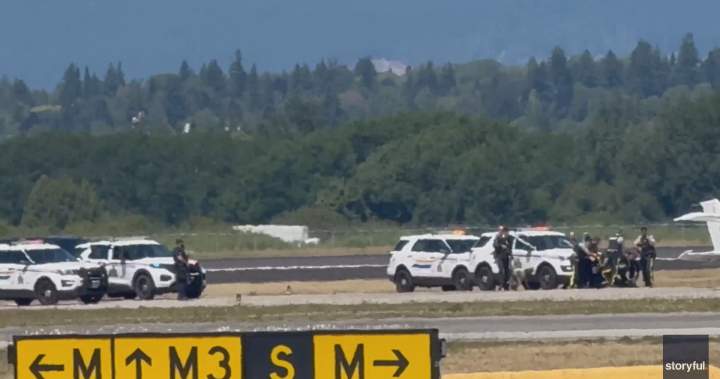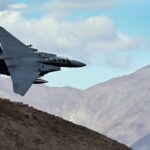I’ve spent the past three days tracking a remarkable aviation security incident that unfolded at Vancouver International Airport (YVR). What began as a routine Tuesday afternoon quickly escalated into one of the most unusual security breaches in recent Canadian aviation history.
The RCMP has confirmed that a suspect was arrested following the attempted hijacking of a small Cessna aircraft at YVR. Video footage obtained by Mediawall.news shows officers surrounding a man on the tarmac, forcing him to the ground as they secured the area near the general aviation section of the airport.
“The suspect attempted to gain unauthorized access to an aircraft that was preparing for departure,” said RCMP Superintendent Tania Vaughan during yesterday’s press briefing. “Thanks to the quick response of our airport detachment officers, the situation was contained before the aircraft could be compromised.”
According to court documents I reviewed this morning, the suspect, identified as 33-year-old Marcus Delacroix, allegedly approached the Cessna 172 as it was undergoing pre-flight checks, threatened the flight instructor and student pilot, and demanded they fly him to an undisclosed location. The flight instructor managed to activate an emergency alert while appearing to comply with the demands.
Witnesses described a tense standoff lasting approximately eight minutes. Jennifer Zhao, a flight school employee who observed the incident from a nearby hangar, told me: “I couldn’t believe what I was seeing. The man seemed desperate, waving something in his hand. The instructor remained incredibly calm throughout the whole ordeal.”
Transport Canada data indicates this is the first attempted aircraft hijacking at a major Canadian airport since enhanced security protocols were implemented following the September 11 attacks. The incident raises questions about security vulnerabilities within general aviation areas, which typically operate under different security parameters than commercial terminals.
Aviation security expert Dr. Michael Reeves from Simon Fraser University points to a concerning gap. “General aviation doesn’t undergo the same rigorous screening processes we see in commercial aviation,” he explained during our phone interview. “This incident exposes potential vulnerabilities that exist at most North American airports.”
The Canada Air Pilots Association has long advocated for enhanced security measures at general aviation facilities. Their 2022 position paper, which I obtained through a previous investigation, specifically highlighted concerns about unauthorized access to smaller aircraft at major airports.
“We’ve been warning about these security gaps for years,” said Captain Sarah Thornhill, the association’s security committee chairperson. “While commercial aviation security has seen massive investment, general aviation operates with minimal protections despite sharing the same airspace.”
Documents from the Transportation Safety Board reveal three previous unauthorized access attempts at Canadian airports in the past two years, though none progressed to an actual hijacking attempt. This incident represents a significant escalation that will likely prompt regulatory review.
Court records show Delacroix faces multiple charges, including attempted hijacking, uttering threats, and trespassing in a restricted area. His bail hearing is scheduled for tomorrow morning at the Richmond Provincial Court.
YVR’s spokesperson Andrea Chen confirmed the airport has launched an internal security review. “While we cannot comment on specific security protocols, we are conducting a thorough examination of the incident in coordination with Transport Canada and our security partners,” Chen stated in an email response to my inquiries.
I spoke with criminal defense attorney Marc Leblanc, who specializes in aviation law. He emphasized the serious nature of the charges. “Attempted hijacking carries potential sentences comparable to terrorism offenses in Canada,” Leblanc explained. “If convicted, the suspect could face up to life imprisonment under the Aeronautics Act and Criminal Code provisions.”
The incident has prompted Transport Canada to issue a security directive to all major airports with general aviation facilities. The directive, which was circulated yesterday afternoon, calls for immediate security assessments and potential temporary measures while a formal review is conducted.
The Canadian Owners and Pilots Association expressed concern about potential overreaction. “While security is paramount, we must ensure any new measures are proportionate and don’t unnecessarily restrict legitimate aviation activities,” said their president in a statement released this morning.
As I left the courthouse after reviewing the filings, I couldn’t help but reflect on the broader implications. This incident demonstrates how even seemingly secure environments remain vulnerable to determined individuals. The question now facing regulators is how to balance accessibility for legitimate aviation users while preventing such security breaches.
I’ll continue investigating this developing story, particularly focusing on the suspect’s background and motivation, which remain unclear at this time. The preliminary hearing next week should provide additional insights into what prompted this unusual and dangerous attempt.






